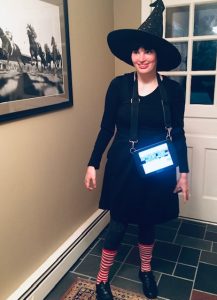What to Know During AAC Awareness Month This October

Because people rarely see an augmentative and alternative communication (AAC) device in action, they don’t recognize it. Most assume Jessie carries an iPad for entertainment. Though talking is amusing, to her it is no game.
When I catch people glancing her way, sometimes I volunteer, “She uses an app called Speak for Yourself to help her talk, and we refer to her iPad as her Talker.”
If they have questions, I either ask Jessie’s permission or I give them a card before sharing personal details.
The question that often goes unasked is, “Why doesn’t she talk?” This leads to a brief introduction to Angelman syndrome. I want others to understand that you shouldn’t assume someone is “less than” because they are unable to speak. Being nonverbal doesn’t indicate a lack of comprehension.
The best way to raise awareness is to see Jessie in action.
Once, while having breakfast at IHOP, our waitress asked Jess what she wanted to drink.
Jess replied, “Orange juice.”
When the waitress left to place our order, I overheard her tell her co-workers, “I just saw this girl use a computer to talk!”
My theory is if one person tells another person, and that person tells someone else, awareness will spread like a “healthy” social disease.
It’s also important to understand that I am not my daughter’s voice. If I were to speak for Jess, she becomes the topic, and that makes her feel diminished. However, I am her advocate, and in that capacity, there’s a difference. My job is to pave the way, not to carry her conversations. Having a voice means having a choice. We may be good at guessing what our children want, but we are not mind readers.
As we raise AAC awareness, we also need to teach people how to have a conversation with someone who uses a device. The process of finding your words on a Talker is much, much slower than speaking. Allowances need to be made. We need to wait for the AAC user to finish their sentence and not fill in their words. No one likes it when a friend or spouse cuts us off mid-sentence. For the AAC user, interruptions are distracting.
When Jessie is with a large group of people, she tends to listen more and talk less. When there is a long enough pause, she sums up the conversation in a word or two. This conveys that she was indeed following along. It’s as if she is E.F. Hutton! During moments like these, I realize Jessie is her own best advocate.
To read more about our journey, visit my blog. We wouldn’t even have a story if Jessie hadn’t found her AAC voice. Also, check Angelman Syndrome News each month for future columns.
***
Note: Angelman Syndrome News is strictly a news and information website about the disease. It does not provide medical advice, diagnosis, or treatment. This content is not intended to be a substitute for professional medical advice, diagnosis, or treatment. Always seek the advice of your physician or other qualified health providers with any questions you may have regarding a medical condition. Never disregard professional medical advice or delay in seeking it because of something you have read on this website. The opinions expressed in this column are not those of Angelman Syndrome News, or its parent company, Bionews, and are intended to spark discussion about issues pertaining to Angelman syndrome.








Leave a comment
Fill in the required fields to post. Your email address will not be published.